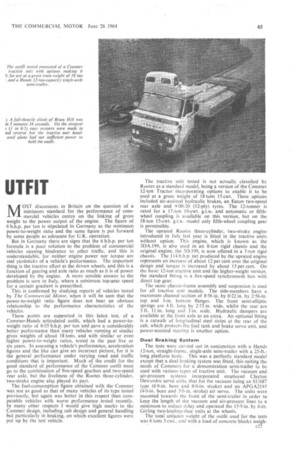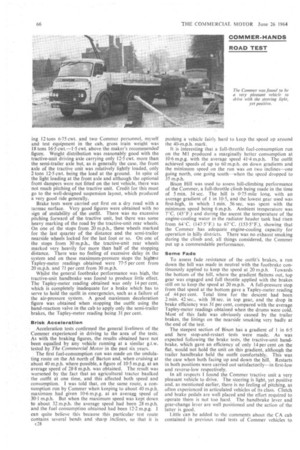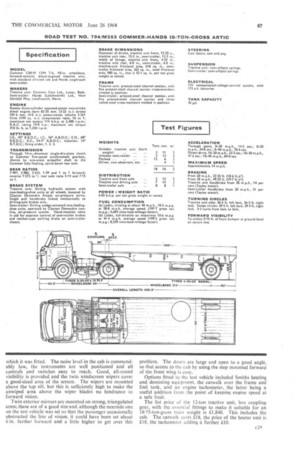LIVELY AND LIKEABL UTFIT
Page 66

Page 67

Page 68

Page 69

If you've noticed an error in this article please click here to report it so we can fix it.
MOST discussions in Britain on the question of a minimum standard for the performance of commercial vehicles centre on the linking of gross weight to the power output of the engine. The figure of 6 b.h.p. per ton is stipulated in Germany as the minimum power-to-weight ratio and the same figure is put forward by some people as adequate for U.K. operation.
But in Germany there are signs that the 6 b.h.p. per ton formula is a poor solution to the problem of commercial vehicles causing hindrance to other traffic, and this is understandable, for neither engine power nor torque are real yardsticks of a vehicle's performance. The important thing is the tractive effort at the driven wheels, and this is a function of gearing and axle ratio as much as it is of power developed by the engine. A more sensible answer to the problem is seen in Italy, where a minimum top-gear speed for a certain gradient is prescribed.
This is confirmed by studying reports of vehicles tested by The Commercial Motor, when it will be seen that the power-to-weight ratio figure does not bear an obvious relationship to the performance characteristics of the vehicles.
These points are supported in this latest test, of a Conn-tier-Hands articulated outfit, which had a. power-toweight ratio of 6-05 b.h.p. per ton and gave a considerably better performance than many vehicles running at similar gross weights of about 18 tons, and with similar or even higher power-to-weight ratios, tested in the past five or six years. In assessing a vehicle's performance, acceleration figures and the like can give an incorrect picture, for it is the general performance under varying road and traffic conditions that is important. Much of the credit for the good standard of performance of the Commer outfit must go to the combination of five-speed gearbox and two-speed rear axle, but the liveliness of the Rootes three-cylinder, two-stroke engine also played its part.
The fuel-consumption figure obtained with the Commer was not as good as that of many vehicles of its type tested previously, but again was better in this respect than comparable vehicles with worse performance ,tested recently. In many other respects I would give high marks to the , Commer design, including cab design and general handling but particularly in braking, on which excellent figures were put up by the test vehicle.
The tractive unit tested is not actually classified by Rootes as a standard model, being a version of the Commer 12-ton Tractor incorporating options to enable it to be used at a gross weight of 18 tons 15 cwt. These options included air-assisted hydraulic brakes, an Eaton two-speed rear axle and 9.00-20 (12-ply) tyres. The 12-tonner is rated for a 17-ton 10-cwt. g.t.w. and automatic or fifthwheel coupling is available on this version, but on the 18-ton 15-cwt. g.t.w. model only fifth-wheel coupling gear is permissible.
The uprated Routes three-cylinder, two-stroke engine introduced in July last year is fitted in the tractive units without option. This engine, which is known as the 3DA.199, is also used in an 8-ton rigid chassis and the original engine, the 31/199, is now offered in a 7-ton rigid chassis. The 114 b.h.p. net produced by the uprated engine represents an increase of about 12 per cent over the original design and torque is increased by about 15 per cent, On the basic 12-ton tractive unit and the higher-weight version, the standard fitting is a five-speed synchromesh box with direct top gear.
The same chassis-frame assemblY and suspension is used for all tractive unit models. The side-members have a maximum channel section of 8-56 in. by 0-22 in. by 2.56-in. top and 3-in, bottom flanges. The front semi-elliptic springs are 4 ft. long by 2.75 in. wide, whilst the rear are 3 ft. 11 in. long and 3 in. wide. Hydraulic dampers are available at the front axle as an extra. An optional fitting is a catwalk of longitudinal steel strips at the rear of the cab, which protects the fuel tank and brake servo unit, and power-assisted steerina, is another option.
Dual Braking System
The tests were carried out in conjunction with a Hands 12-ton, straight-frame, single-axle semi-trailer with a 25-f t.long platform body. This was a perfectly standard model except that a dual braking system was fitted, this suiting the needs of Commers for a demonstration semi-trailer to be used with various type; of tractive unit. The vacuum and air-pressure systems incorporated employed Clayton Dew andre servo units, that for the vacuum being an S1/687
type (6.9-in. bore and stroke) and an APGA2195 (4.0-in, bore and 5-0-in, stroke) air servo. The units were mounted towards the front of the semi-trailer in order to keep the length of the vacuum and air-pressure lines to a minimum to reduce delay and operated the 15-5-in, by 6-in. Girling two-leading-shoe units at the wheels.
The total unladen weight of the outfit used for the tests was 6 tons 5 cwt., and with a load of concrete blocks weight-27 ing 12 tons 6-75 cwt. and two Commer personnel, myself and test equipment in the cab, gross train weight was 18 tons 16.5 cwt.-1-5 cwt. above the maker's recommended figure. Weight distribution was reasonably good with the tractive-unit driving axle carrying only 12.5 cwt. more than the semi-trailer axle but, as is generally the case, the front axle of the tractive unit was relatively lightly loaded, only 2 tons 12.5 cwt. being the load at the ground. In spite of the light loading at the front axle and although the optional front dampers were not fitted on the test vehicle, there was not much pitching of the tractive unit. Credit for this must go to the well-designed suspension layout, which produced a very good ride generally.
Brake tests were carried out first on a dry road with a tarmac surface. Very good figures were obtained with no sign of instability of the outfit. There was no excessive pitching forward of the tractive unit, but there was some heavy marking of the road by the tractive-unit rear wheels. On one of the stops from 20 m.p.h., these wheels marked for the last quarter of the distance and the semi-trailer nearside wheels locked for the last foot or so. On one of the stops from 30 m.p.h., the tractive-unit rear wheels marked very heavily for more than half of the stopping distance. There was no feeling of excessive delay in the system and on these maximum-pressure stops the highest Tapley-meter readings obtained were 77-5 per cent from 20 m.p.h. and 71 per cent from 30 m.p.h.
Whilst the general footbrake performance was high, the tractive-unit handbrake was found to produce little effect. The Tapley-meter reading obtained was only 14 per cent, which is completely inadequate for a brake which has to serve to hold the outfit in emergencies, such as a failure of the air-pressure system. A good maximum deceleration figure was obtained when stopping the outfit using the hand-reaction valve in the cab to apply only the semi-trailer brakes, the Tapley-meter reading being 31 per cent.
Brisk Acceleration
Acceleration tests confirmed the general liveliness of the Commer experienced in driving to the area of the tests. As with the braking figures, the results obtained have not been equalled by any vehicle running at a similar g.t.w. tested by The Commercial Motor in the past six years.
The first fuel-consumption run was made on the undulating route on the A6 north of Barton and, when cruising at about 40 m.p.h. where possible, a figure of 10-5 m.p.g. at an average speed of 28-8 m.p.h. was obtained. The result was worsened by the fact that an agricultural tractor baulked the outfit at one time, and this affected both speed and consumption. I was told that, on the same route, a consumption run by Commer when keeping to about 40 mph. maximum had given 10-6 m.p.g. at an average speed of 30.1 m.p.h. But when the maximum speed was kept down to about 32 m.p.h. the average speed had been 28 m.p.h. and the fuel consumption obtained had been 12.2 m.p.g. I can quite believe this because this particular test route contains several bends and sharp inclines, so that it is
c28 pushing a vehicle fairly hard to keep the speed up around the 40-m.p.h. mark.
It is interesting that a full-throttle fuel-consumption run on the Ml produced a marginally better consumption at 10.6 m.p.g. with the average speed 41.4 m.p.h. The outfit achieved speeds of up to 60 m.p.h. on down gradients and the minimum speed on the run was on two inclines—one going north, one going south—when the speed dropped to 35 m.p.h.
Bison Hill was used to assess hill-climbing performance of the Commer, a full-throttle climb being made in the time of 5 Min. 34 sec. The hill is 0-75 mile long, with an average gradient of 1 in 10.5, and the lowest gear used was first-high, in which 1 min. 56 sec. was spent with the minimum speed being 6 m.p.h. Ambient temperature was 7°C. (45°F.) and during the ascent the temperature of the engine-cooling water in the radiator header tank had risen from 64C. (147.5°F.) to 67°C. (153.5°F.), showing that the Commer has adequate engine-cooling capacity for operation in hilly districts. There was no exhaust smoking during the climb and, all things considered, the Commer put up a commendable performance.
Some Fade
To assess fade resistance of the outfit's brakes, a run down the hill was made in neutral with the footb rake continuously applied to keep the speed at 20 m.p.h. Towards the bottom of the hill, where the gradient flattens out, top gear was engaged and full throttle applied with the brakes still on to keep the speed at 20 m.p.h. A full-pressure stop from that speed at the bottom gave a Tapley-meter reading of 44 per cent. Total time for the descent had been 2 min. 42 sec., with 38 sec. in top gear, and the drop in brake efficiency was 31 per cent, compared with the average Tapley-meter readings obtained when the drums were cold. Most of this fade was obviously caused• by the trailer brakes, the linings on the nearside smoking very badly at the end of the test.
The steepest section of Bison has a gradient of 1 in 6.5 and here stop-and-restart tests were made. As was expected following the brake tests, the tractive-unit handbrake, which gave an efficiency of only 14 per cent on the flat, would not hold the unit on this gradient, although the trailer handbrake held the outfit comfortably. This was the case when both facing up and down the hill. Restarts in both positions were carried out satisfactorily—in first-low and reverse-low respectively.
In all respects I found the Commer tractive unit a very pleasant vehicle to drive. The steering is light, yet positive and, as mentioned earlier, there is no feeling of pitching, as often experienced in articulated vehicles of its class. Clutch and brake pedals are well placed and the effort required to operate them is not too hard. The handbrake lever and gear-change lever are well positioned and the action of the latter is good.
Little can be added to the comments about the CA cab contained in previous road tests of Commer vehicles to which it was fitted. The noise level in the cab is commendably low, the instruments are well positioned and all controls and switches easy to reach. Good, all-round visibility is provided and the twin windscreen wipers cover a good-sized area of the screen. The wipers are mounted above the top sill, but this is sufficiently high to make the unwiped area above the wiper blades no hindrance to forward vision.
Twin exterior mirrors are mounted on strong, triangulated arms; these are of a good size and, although the nearside one on the test vehicle was set so that the passenger occasionally obstructed the line of vision, it could have been set about 6 in. farther forward and a little higher to get over this problem. The doors are large and open to a good angle, so that access to the cab by using the step mounted forward of the front wing is easy.
Options fitted to the test vehicle included Smiths heating and demisting equipment, the catwalk over the frame and fuel tank, and an engine tachometer, the latter being a useful addition from the point of keeping engine speed at a safe limit.
The list price of the 12-ton tractive unit, less coupling gear, with the essential fittings to make it suitable for an 18.75-ton-gross train weight is £1,840. This includes the cab. The catwa1k costs £18, the price of the heater unit is £.18, the tachometer adding a further £10.




























































































































